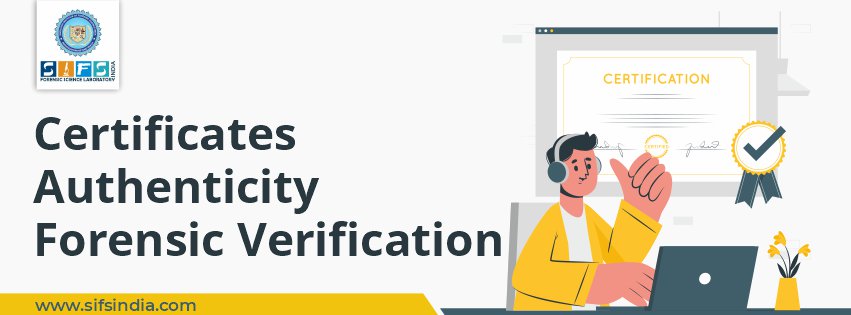Authentication is the process of establishing or proving the genuineness of something either video, certificate, documents, signature, etc.
Authentication of certificates is a part of questioned document division in the field of forensic science.
Certificate in general means a legal and valid document that states that the information present in it is genuine and true.
It can be a birth certificate, educational certificate, marriage certificates, work experience certificate, death certificate, etc. In any legal/court process the authenticity of these certificates plays a very important role.
There are many cases of disputed certificates, where their authenticity is questioned, for example, students submitting their fake mark sheet in institutes, or customers depositing fake property papers in banks for loan purposes or the use of counterfeiting currencies.
So, establishing the authenticity of the certificates is very important. Sometimes certificates are in the form of digital media also.
The first question that a document examiner needs to answer is whether the document is genuine or not, then to determine the time when it was created and to reveal the modifications or changes made with respect to the original document.
Certificate Verification Techniques Used by Forensic Experts
Different techniques are used for the authentication of certificates or documents depending upon the type of case. In the case of a cheque whose authenticity needs to be established, the examination is performed using IR radiations as different ink reacts differently so the ink that is used in the whole cheque reacts differently than that of the ink used for alteration.
In the case of certificates where a seal, watermark, or stamp is present, their examination by microscope leads to the authentication of documents as every stamp or seal has unique manufacturing marks during the heat seal process which cannot be duplicated. ESDA is used to reveal the indentations present on the document.
In case of disputed educational certificates that are used by students to take admission in universities, the atheneum is checked by examining the age of paper or type of paper.
For example, a student passed 12 in 2000 but the paper of his/her certificate started manufacturing after 2005, proving the certificate to be forged.
In educational certificates, the name of the student along with the parent’s name, date of birth is examined further. The photo of the student is also examined using different software for establishing the authenticity of the certificate.
In the case of counterfeiting currencies, fake passports, fake id cards, fake atm cards, fake visas, the security features of these documents are observed under the UV lamp and stereo microscopes such as presence or absence of security threads, IV fluorescent paper, UV fluorescent optical fibers, hidden watermarks, forged diplomatic e-passport symbol, presence of genuine, logo, embossing stamp, stitching threads in visa, security thread, serial number, rainbow and guilloche pattern on judicial stamp papers.
Educational certificates of graduation, secondary school or high school are generally paper-based and have wet signatures, holograms, and stamps on them that reflect originality.
OCR i.e. optical character recognition is a technique used to authenticate the documents. In this the features of the documents to be verified are fetched and then compared with the known original document database.
The hash value is another way to authenticate the certificates where the first hash value is computed in the document enrollment stage and then stored in a hash value database.
The certificate is authenticated by computing the hash value again in the authentication stage and the resulting hash value is compared with the database.
In the authentication of certificates, barcode technology is used for obtaining the hidden data by scanning and decoding the barcode.
2D barcode is used to authenticate the hardcopy of mark sheets as it contains the encrypted data of the document.
QR code is a means of paper-based authentication, but can only be applied between the known sender and receiver. This code in the document is scanned then the decryption of data occurs revealing the information and digital signature of the certificate.
Video spectral comparator and stereo microscope are used to authenticate the certificate where instead of the original certificate, colored photocopies are given.
The observation of photocopied color certificates under stereomicroscope show less cellulose fiber density and ink distribution density as compared to the original documents and under VSC micro lettering and silken threads can be observed which are only present in original documents/certificated and not in color photocopies or fake documents.
In India all the legal procedures are based on the authentication of legal documents, so their verification is very important.

 February 07, 2021 - BY SIFS India
February 07, 2021 - BY SIFS India